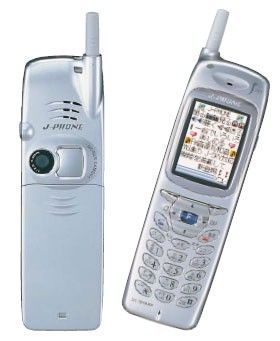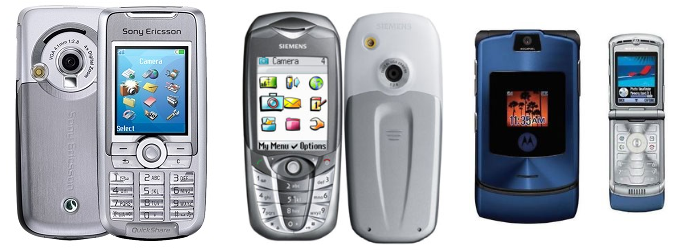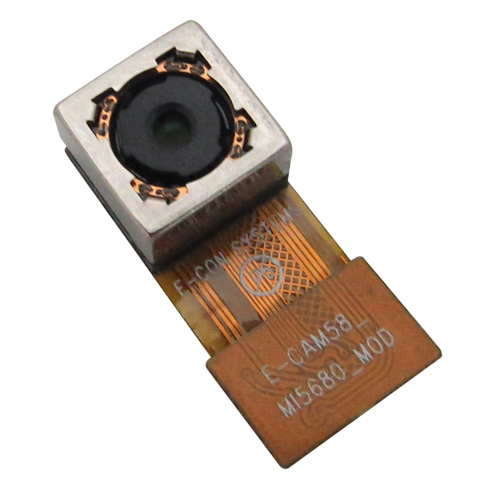A brief history of the cameras in the phones (article plus video)

Did you know that the first camera phone came onto the market back in 1999? It was called Kyocera VP-210. Moreover, the camera he had a front and only for videophone. Of course, the Japanese did this miracle.
Over the next eighteen years, cameras in mobile phones have turned from children's toys into a great tool, and continue to evolve. I want to follow the path of development of mobile photography and video, and conduct an intermediate result at the end of this year.
Many pictures

A brief history of cameras in the phones
In 2000, Samsung released the SCH-V200 phone, which had a rear camera for a photo, and which usually deprived the title of the first camera phone, because the camera’s software didn’t interact with the phone’s software, and the photos could only be obtained by connecting to a computer. In fact, these are two devices with one screen. The camera there was absolutely touching by today's standards. 0.11 megapixel resolution and the corresponding picture quality.

In the same 2000, Sharp J-SH04 came out, which just bears the title of the first full-fledged phone with a camera. The sensor is basically the same. And what else is there, when the screen is tiny and displays only 256 colors.

Over the next four years, cameras in telephones have become more or less common. In the process, interesting solutions appeared, such as the Siemens C60 or Erickson T68i, to which the camera could be purchased and attached. In general, this is the time of the origin of the function, when the companies one after another released models with cameras as one of the chips. Photography there and did not smell.

Resolution has grown to 0.3 megapixels. This is a classic figure that can still be found on some penny webcams. It means that the camera produces a frame resolution of 640 × 480 pixels. Often this format was called VGA, which is more marketing simplification than actual compliance with the standard.
Such sensors were, for example, in the popular Siemens phones of the 65th series. They were also able to record 30-second videos with a resolution of 176 × 132 in a memetic format of 3gp with strong compression and mono sound.
I personally held in my hands in those years a digital camera the size of a modern ultrazoom, which had a 0.3 megapixel sensor. On a thin screen, you could roughly preview something dark and muddy with a frequency of not more than one frame per second.
Plus or minus, the flagship phones showed equally frivolous photo capabilities. Although at home something sfotkat it was quite possible. Flashes began to appear next to the cameras, and they even flashed a little. Some even printed such photographs, although the resolution gave out squares even at 9 × 12.
Sony Ericsson K700, Siemens CX-65, Motorola Razr V3 - it's all from that era, 2004th.

The next stage: 1.3 megapixel sensors. This is 1280 × 1024 pixels (sometimes 1280 × 960 or some other exotic variant), which, in principle, covers the HD standard. However, when there were phones with such sensors, their performance and close did not allow to write video in good resolution. And the quality of sensors and optics was such that it would not have been possible to get adequate 30 frames per second even in good light: the automatics had to expose the shutter speed in a fifth of a second so that the picture was not completely dark. However, the phones of that generation usually knew how to write 176 × 144 or even 320 × 240 videos. The photos were bad, the compression of the dzhipega was very strong, and the color rendition, even on a clear day, did not allow photographing the flowerbed so that the flowers did not turn from something colorful to something dirty.
But in the same 2005, the famous Sony Ericsson K750i came out, which already had autofocus, a 2-megapixel sensor, and the resolution of the image is slightly higher: 1632 × 1224. The critics then praised the camera, and it really was the best among the phones, but it still was not enough to attract the attention of photographers.

The year 2006 is the growth of megapixels, the mass appearance of autofocus in phones and, in principle, everything. Camera phones began to form a separate and, as it turns out, a dead subclass.
The Nokia N93 came out with a five-megapixel sensor, triple optical zoom and optical stabilization. The device was focused on video: 480p, adult H.263 and H.264 codecs. By the way, even then, Nokia had optics from Carl Zeiss.

The year 2007 is the same for the cameras. Slowly growing. Yes, and what could be the emphasis on the photo-function, when the iPhone comes out and turns the game over. The iPhone itself had a quite modest 2 megapixel camera and the phone didn’t even offer the possibility to make a video.
But increasingly, all sorts of clever things appear in the camera software, such as face recognition and smiles.
In 2008, those models in which the focus was on the camera, began to look like mini-soap dishes with large screens. The standard resolution of the sensors ranged from 3.2 to 5 megapixels. The quality of the pictures began to approach the soap dish, and the video in 480p has ceased to be something amazing.
By the end of the year, the LG KC910 even came out with an 8-megapixel camera! This means that the resolution of the images has grown to 3264 × 2448 nestydnyh.

In 2009, came out the camera phone Samsung PIXON12 with a 12-megapixel sensor, which has already argued with the soap box on resolution.

A new iPhone 3GS learned how to shoot a video and did it at 480p.
At the same time, mirrorless cameras began to appear, but a wide audience did not hear anything about them then.
Here somewhere from this time, maybe, a year later, the crowding out of soap cases from the market begins.
In 2010, the fourth iPhone learned to write video in HD and received the famous retina screen. Samsung Galaxy S came out with the same video in HD. The flagships began to have a memory capacity of eight gigabytes, and many allowed it to expand by purchasing a memory card. The whole photo collection could be at hand.
The next few years, the cameras got better and better, and there is less and less sense in buying a separate camera. All boasted megapixels, but, besides the growing resolution, there was a qualitative growth.
The phones began to put sensors with reverse flare, which took more light and as a result made less noise. Optics are getting better.
True, the rejection of individual cameras deprived users of, for example, optical zoom.
In 2011, the fourth iPhone became the most popular camera on Flicker, and since then the phrase “iPhone is the most popular camera” has become a tehnomem and has earned a lot of applause from Apple presentations.

From this point on, the manufacturers of compact cameras seriously felt the need to offer something new, because the cheerful shouts about dozens of megapixels stopped working: they had only five iPhones.
In 2012, the 808th Nokia was released. Plump, outdated Symbian OS, but with an amazing 41 megapixel sensor. Until now, this is a quantitative record in mobile cameras. It was possible to get a little confused and get a picture with a resolution of 7728 × 5368 pixels.

New trends in mobile cameras re-installed Apple. In 2013, Phil Schiller introduced 5s and expanded the auto-HDR features and the ability to shoot video at 120 frames per second.
And LG, along with Google, released Nexus 5, the silhouette of which is still often seen around the demo screenshots of Android applications. It is important for us that the HDR + mode was again qualitatively implemented in it, which allowed the software to expand the dynamic range of the mobile camera.

Nokia, already as part of its long attempt to be on the smartphone market with Windows Phone operating systems, released Lumiya 1020 with the same 41 megapixels. The advertising company was pushing for camera capabilities, which was further improved after the 808th model. They said that such a sensor is useful, even if you do not need insane resolution: mixing several pixels into one allows you to reduce the noise of the final photo.

Even by this time, phones that shoot video in FullHD, have become normal.
Selfies, about which few people have heard before, have become the most popular genre of household photography. Responsibility for this lies on the good cameras in the phones in half with social networks.
And then it finally became clear that the segment of household cameras finally disappeared as an independent phenomenon. And the more interesting to observe the development of mobile cameras and related engineering solutions.
It is clear that to compete with large cameras in the iron part will not work when you have to cram the camera module into a thin phone case, which is already densely filled with accessories.

But some basic advantages such a camera gets even in comparison with professional solutions. For example, the best generation mobile processors, the best performance among mobile devices, a bunch of related sensors - and we are now talking about flagship devices - are exactly smartphones. Or a huge user base with Internet access (which is important when it comes to different self-learning processing algorithms).
However, these advantages still need to be properly used. And - if we take the death of the digital camera market as an argument - the companies producing the phones managed to use them correctly. And the main reason for success is software.
It is software solutions that make it possible to reach the level of a picture obtained from a small sensor through a slightly simpler optics, such as is not ashamed to boast at the presentation of the next phone model.

To a level where more and more clips appear on YouTube with comparisons of the photo capabilities of phones and DSLRs in which the former do not fail the tests with a bang.
Yes, with restrictions, yes, under certain conditions, but for several years now we can get good pictures on the phone. For example, at the meeting we did with subscribers back in 2016, besides the quacking of ducks, you could hear the story of how a professional gives customers pictures, among which there are several shot on the sixth still iPhone, and no one notices the difference.
Today everything is even better. Auto-HDR, helping to overcome the modest dynamic range of the sensor; smart background blur based on the depth map created with the second camera, or with the help of increasingly smarter neural networks; optical zoom, implemented by the same second module; the most advanced screens on the market, allowing you to immediately see the photo in high resolution and with excellent color reproduction.
More interesting is the case with video. 60, 120, 240 and even a record crazy 960 frames per second in Sony's smartphone, even if he does it for a short time and only at 720p. Increasingly advanced stabilization systems, both optical and digital. It is not surprising that video bloggers often travel without cameras, even without Goupro, preferring a phone with a bank.
It is interesting, by the way, whether such technical availability will lead to a good video recording to the mass appearance of graphomanes from the cinema, or new video-creation formats will arise.
The bottom line: they remove today's phones well, but with reservations. The professional will obviously be closely filmed in the face of mobile photography restrictions. But the professional must also appreciate the benefits that the development of mobile cameras has had in the digital photo market as a whole.
In addition to new software development, it was the death of the digital soap dish market that made second-tier manufacturers cheer up and start offering compact cameras a higher class.
Well, how not to end with commonplace banality: the best camera is the one that you have with you. And we always have a smartphone with us.
Roller
In the article format, this story of cameras in the phones I prepared for Giktatimes, but initially we made a video that I left below. It has an offscreen text with historical and technical illustrations.
All Articles